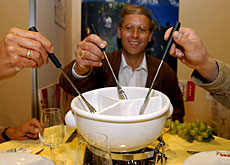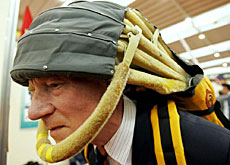Geneva is the master of invention

An aeroplane with flapping wings, an earthquake alarm clock and various marital aids will all be vying for a commercial break in Geneva this week.
They are among around 1,000 potentially useful or downright oddball products hoping to catch the eye at the 34th International Exhibition of Inventions, which runs from April 5-9.
According to organisers, the spirit of invention is very much alive as shown by the record 775 exhibitors from around the world making the trip to Geneva this year.
But Jean-Luc Vincent, president and founder of the event, says a large number of would-be inventors are failing to see their ideas through to completion for two main reasons.
“The first is the fear of being taken for a crank. This intellectual reflex does exist and is a powerful brake for many researchers,” he said. “To those people who systematically deride inventors and inventions, we ask them to stop.”
The second and perhaps more serious reason lies with the difficulty of pitching an invention in a global marketplace where seller and potential buyer can often be continents apart.
Hence, say organisers, the need for an international meeting point where inventors can rub shoulders with manufacturers, distributors and investors. Vincent points out that each year more than 45 per cent of the inventions exhibited are the object of licensing contracts.
Strong Malaysian presence
This is good news for the class of 2006, the bulk of whom come from Europe and Asia. This year Malaysia leads the field with 152 exhibitors, followed by Russia (72), Iran (62) and France (60).
Only two exhibitors will be attending from the United States. But while lacking in numbers, the Americans should still make an impression.
One of their inventions is an aeroplane that flies “thanks to double or multiple wing flapping”; the other is “make-up eyeglasses” that help you to see straight when applying mascara.
Elsewhere Swiss inventor Eric Widell will be displaying a mobile anti-flood dam that might sit well alongside a floating micro-hydropower station designed by a Moldovan.
Over in the security section investors will find a centrifugal parachute for escaping from high buildings and a Chinese earthquake alarm clock, described as “a lovely timepiece whose alarm rings when there is an earthquake”.
Other eye-catching devices include an optical kit for evaluating the heat of chillies, a vibrating ring that boosts sexual pleasure and various anti-snoring devices.
Growth areas
Anne Loertscher, assistant manager of the exhibition, says growth areas in recent years have been medicine, orthopaedics, materials for the disabled, and food and drink.
As for the ease or difficulty of getting a device onto shop shelves, much depends on where you live.
“Certain countries have a whole structure of inventing, presenting, meeting the necessary partners and then getting onto the market very, very fast,” Loertscher told swissinfo.
“Others – mainly west European countries – have none of this. This is why the international exhibition exists: to get all inventions onto the global market.”
swissinfo, Adam Beaumont in Geneva
An invention may only be exhibited in Geneva once and must be protected by intellectual property rights.
The Swiss Federal Institute of Intellectual Property has organised a stand including representatives from the World Intellectual Property Organization, the European Patent Office and patent offices from ten countries.
Around a third of the record 775 exhibitors are independent inventors and researchers; the rest are companies, research institutes and universities.
Guests of honour will be the French prototype Helios and Switzerland’s SwissSpirit, which will both be taking part in the 2007 World Solar Challenge in Australia.
Global turnover from the exhibition is estimated at SFr40 million ($30.5 million).
75,000 visitors are expected – 55% of them industrialists, distributors and businessmen.
57% of exhibitors come from Europe, 38% from Asia and 5% from other continents.
8% of them are Swiss.

In compliance with the JTI standards
More: SWI swissinfo.ch certified by the Journalism Trust Initiative


You can find an overview of ongoing debates with our journalists here. Please join us!
If you want to start a conversation about a topic raised in this article or want to report factual errors, email us at english@swissinfo.ch.